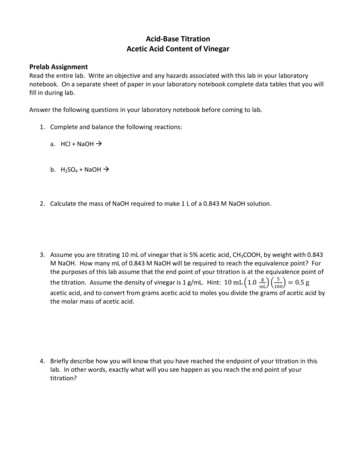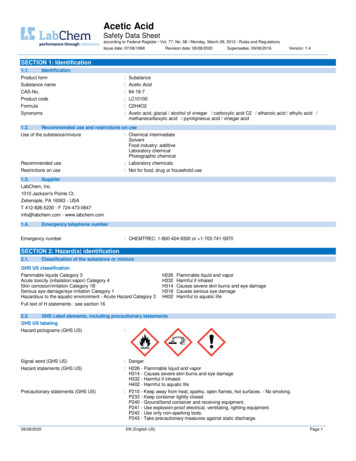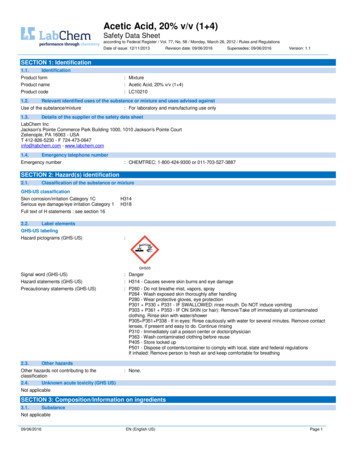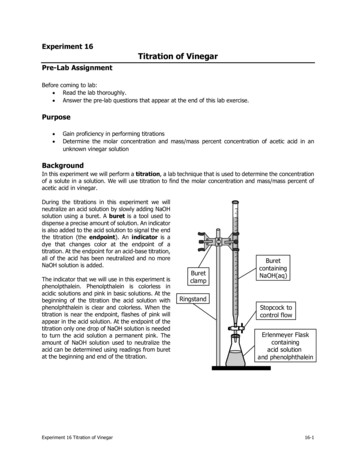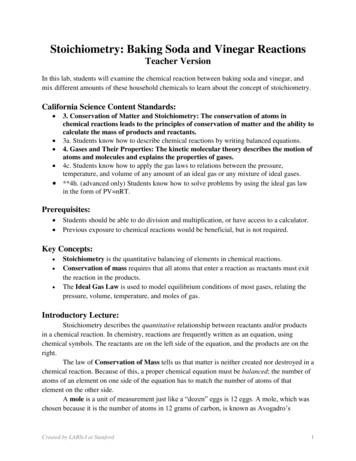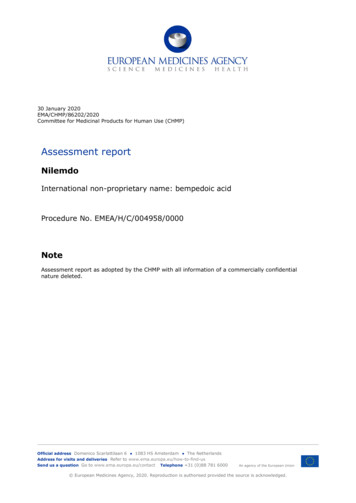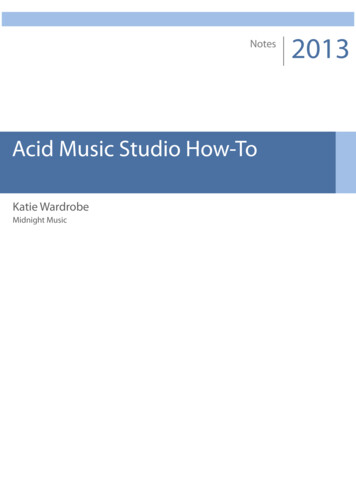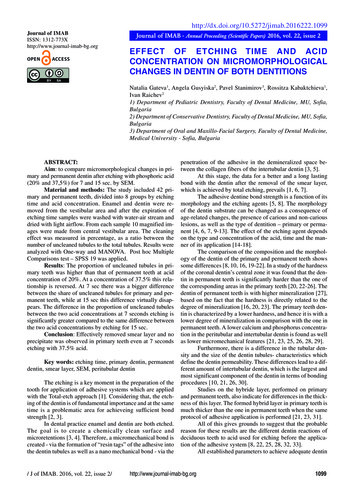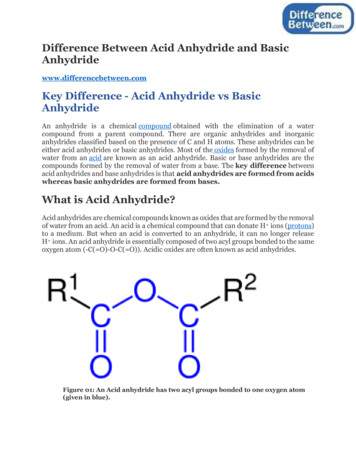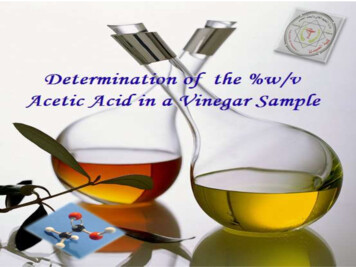
Transcription
Vinegar is a liquid consistingmainly ofAcetic Acid( CH3COOH ) and water.
Glacial Acetic AcidIt is a water-free ( anhydrous ) acetic acid,the name comes from the ice - like crystalsthat form slightly below room temperatureat 16.6 C .An abbreviation for acetic acid is HAcwhere Ac stands for acetate, CH3COO–Acetate is the ion resulting from loss ofH from acetic acid.Ice - like crystalsof Glacial Acetic Acid
Preparation of unknown acetic acid solution:1- Transfer 10 ml of unknown by using 10 mlbulb pipette into a 100 ml volumetric flask.2- Complete the volume with distilled water.3- Stopper the flask and shake well.
Name of Experiment: Acid - Base Titration.Aim of Experiment: Determination of %w/v Acetic Acidin an unknown Vinegar sample .Principle:Acetic acid is a weak acid Ka 1.8 x 10-5 , So titration ofacetic acid against NaOH is a titration of a weak acid againsta strong base. The end point will be not very sharp.Procedure:1- Using a 10 ml bulb pipette transfer10 ml of the prepared solution to aconical flask.2- Add 2 drops of ph.ph. indicator.3- Fill the burette with 0.1 N NaOHstandard solution.
4- Titrate the prepared aceticacid solution with standardNaOH soln. until the colorof the indicator becomesfaint pink.Calculations:Beforeend pointEnd pointAfterend point
Calculate the % w/v HAc for 10 ml sample of avinegar that required 30ml of 0.2N NaOH soln.?Knowing that the atomic masses for Na 23 ,O 16 , H 1 and for C 12.
In general,For weak acid titrations,the pH at the end point is above 7, So ph.ph. is themost suitable indicator which can be used.For weak bases ,the pH at the end point is below 7, So M.R. ( 4.2 –6.2 ) or M.O. ( 3.1 – 4.4 ) are widely used.For strong acids & strong bases,M.R. , Bromothymole blue , ph.ph. are most suitable.
Phenolphthalein indicator is themost frequently used indicatorin the titration of acetic acidwith NaOH standard solution ?The pH of the solution at the equivalence pointwill be above pH 7, (pH about 8.72 ), So ph.ph.is used ( since the pH at the end point of thistitration is within the pH range of ph. ph.Indicator which is 8.3 – 10 ).
Methyl red or methyl orange cannot be used as indicators in thisexperiment?The pH of the soln. at the equivalence pointwill be above pH 7, (pH about 8.72 )M.R (4.2–6.3) or M.O. (3.1–4.4) can not beused since they change color at much lower pH(i.e.) before the end point of titration is reached.
Basic Equipments and Instrumentsused in Chemistry laboratory:Balance:It is an instrumentfor measuring mass.
Pipettes:They are used to transfer of known volumesof liquids from one container to another.Common types are shown in the figure:(a) Volumetric or bulb pipette delivers a singlefixed volume of liquid.(b) Mohr or graduated pipettes are calibratedin convenient units to permit the deliveryof any volume up to the maximumcapacity.
Flasks:There are various types of flasks:Erlenmeyer or Conical Flask:It's used in chemistrylabs for titration ,as they can holdthe contents mixedsingle-handed leavingthe other hand freeto add the reagent .
Buchner ( Vacuum ) Flask:It's a thick - walled Erlenmeyer flask witha short glass tube , used for filtration ofsample under vacuum.Buchner(Vacuum )Flask
Volumetric, Measuring or Graduated , Flask:It is a pear - shaped, with a flat bottom , it'sneck is elongated and narrowed with ansingle etched ring graduation marking .There aredifferent sizesof volumetricflaskswhichare used forprecise dilutionand preparationof standard solutions.
Boiling Flask:They are used for boiling liquids and in dist illation apparatus.(a) is a round – bottomed boiling flask .(b & c) are multi – necked round – bottomedBoiling flasks .
Funnels:Various types of funnels are present:Ordinary Funnel:It's used for filtration and transfer of liquidsand powder from one container to another.
Buchner Funnel:It's made of porcelain and it has a perforatedporcelain plate to support a filter paper.A Buchner funnel is used in conjunctionwith a filter ( vacuum ) flask or tube forfiltration by suction, ( vacuum filtration ).
Separatory Funnel:It is used for separation of two or moreimmiscible liquids, ( extraction process ).
Funnel Support:It is used to support and hold funnels.Stand:It is used to support equipments.
Clamp:When attached to the stand, this clamp isused to hold a large glassware above the labtable.Iron Ring:It’s used to supportglassware above thelab table.
Graduated Cylinder:They are not highlyaccurate , but theyare often used tomeasure specifiedquantities of liquids.Beaker:It is of multipurpose and essential in the lab.Beaker isused tohold liquids.
Reagent Bottles:They canbe used forstorage ofchemicalreagents .Washing Bottle:It's filled with distilled water to wash & cleanlaboratory glasswares & rinsingsolids out of acontainer whenfiltering.
Test Tubes:They are widely used by chemists to hold, mixor heat small quantities of solid or liquidchemicals, especially for qualitative assaysand experiments.Test Tube Rack:It is used tohold test tubeswhile reactionshappen in themor while theyare not needed.
Test Tube Holder:It is used to hold testtubes when they arehot & untouchable .Test Tube Brush:Test tube brush is usedto easily clean the insideof a test tube.Bunsen Burner:It is used for heatingand exposing itemsto flame.
Ring Stand:Ring or tripod stands are usedto hold items being heated .Wire Gauze:Wire gauze, when placed between glassware &a heat source , diffusesthe heat somewhat andis therefore safer thana direct flame .Spatula:Stainless steel and nickelspatula is used for handling ofsmall quantities of material.
Filter Paper:It’s an important filtering medium.Ashless paper is made fromcellulose fiber .Watch Glass:It is used to hold solidswhen being weighed ortransported .It can also be used to coverbeakers .It shouldnever beheated .
Stirring Rod:It is a glass rod used for stirringof liquids .Rubber Policeman:It's a small section of rubbertubing that has been crimp ed on one end.The open end of the tubingis fitted on to the end of a stirr ing rod.It is used in chemical lab. totransfer residues of precipitateor solid on glass surfaces whenperforming gravimetric analysis.
Crucible and Cover:Crucibles are used as a container when some –thing requires "strong" heating.CrucibleTong:These tongsare used forpicking upcruciblesand cruciblecovers only.
Clay Triangle:It’s used to hold crucibles when theyare being heated . It usually sit ona ring stand .Reflux Condenser:It's employed for both reflux and for downwarddistillation.
Vacuum Desiccators :Solids which are moist witheither water or organic solventsare routinely dried in a vacuumdesiccators at room tempera –ture .Burettes:Burettes, like measuring pipettes, makeit possible to deliver any volume up tothe maximum capacity of the device.The precision attainable with a buretteis greater than the precision witha pipette . Burette is used in titrationsto measure precisely how much liquid isused.
What are the rules that should be followed toprevent contamination of reagents & solutions?What are the general rules of safety workingin a chemical laboratory?Referance:Douglas A. Skoog , West , Holler and Crouch, Fundamentals ofAnalytical Chemistry, 9th edition, page 14 - 47, 2014.
Molar mass 36.5 g.molsp.gr 1.18 g.L –37% HCl (w/w)–
1- Calculation of the Normality ofthe concentrated HCl:2- Calculation of the volume of 11.961N HCl thatshould be taken to prepare 1L of 0.1N HCl soln.
If the chemical is available in a pure state, e.g.anhydrous Na2CO3 , weigh out an exact quantity,dissolve it in water up to volume.How could you prepare 0.5 L of 0.1 NNa2CO3? Knowing that, atomic massesof Na 23, O 16 and C 12.Substances which are not usually obtained ina pure state , e.g. mineral acids and caustic alkali, areprepared as approximate solutions and standardizedagainst a known pure std., e.g. Na2CO3 as a primarystd. soln.
Procedure:1- Fill the burette with the prepared HCl soln.2- Transfer 10 ml of exactly 0.1 N Na2CO3solution ( 1o - standard ) in to a conicalflask by using a 10 ml bulb pipette.3- Add 2 drops of methyl orange asindicator. Yellow color is obtained.
4- Titrate with HCl soln. drop bydrop from the burette in to theconical flask until a faint orangecolor is obtained.5- The exact normality can be calculated fromthefollowing equation,2 NaCl H2O CO2Na2CO3 2 HClN1 * V1Na2CO3 N2 * V2HCl
Directions for reading a volumetricequipment:Avoiding a parallax:The top surface of a liquid confinedin a narrow tube exhibits a markedcurvature, meniscus.It's common practice to use the bottom of themeniscus.Post Lab Exercise:A bottle of concentrated HCl has the followinginformations on it's label: molar mass is 36.5 g/mol,sp.gr. 1.18 g/L and 40% HCl ( w/w ) .a- What is the normality of the HCl in the bottle?b- How could you prepare 2 liters of about 0.1 N HClsolution from the concentrated reagent?
Vinegar is a liquid consistingmainly ofAcetic Acid( CH3COOH ) and water.
Glacial Acetic AcidIt is a water-free ( anhydrous ) acetic acid,the name comes from the ice - like crystalsthat form slightly below room temperatureat 16.6 C .An abbreviation for acetic acid is HAcwhere Ac stands for acetate, CH3COO–Acetate is the ion resulting from loss ofH from acetic acid.Ice - like crystalsof Glacial Acetic Acid
Preparation of unknown acetic acid solution:1- Transfer 10 ml of unknown by using 10 mlbulb pipette into a 100 ml volumetric flask.2- Complete the volume with distilled water.3- Stopper the flask and shake well.
Name of Experiment: Acid - Base Titration.Aim of Experiment: Determination of %w/v Acetic Acidin an unknown Vinegar sample .Principle:Acetic acid is a weak acid Ka 1.8 x 10-5 , So titration ofacetic acid against NaOH is a titration of a weak acid againsta strong base. The end point will be not very sharp.Procedure:1- Using a 10 ml bulb pipette transfer10 ml of the prepared solution to aconical flask.2- Add 2 drops of ph.ph. indicator.3- Fill the burette with 0.1 N NaOHstandard solution.
4- Titrate the prepared aceticacid solution with standardNaOH soln. until the colorof the indicator becomesfaint pink.Calculations:Beforeend pointEnd pointAfterend point
Calculate the % w/v HAc for 10 ml sample of avinegar that required 30ml of 0.2N NaOH soln.?Knowing that the atomic masses for Na 23 ,O 16 , H 1 and for C 12.
In general,For weak acid titrations,the pH at the end point is above 7, So ph.ph. is themost suitable indicator which can be used.For weak bases ,the pH at the end point is below 7, So M.R. ( 4.2 –6.2 ) or M.O. ( 3.1 – 4.4 ) are widely used.For strong acids & strong bases,M.R. , Bromothymole blue , ph.ph. are most suitable.
Phenolphthalein indicator is themost frequently used indicatorin the titration of acetic acidwith NaOH standard solution ?The pH of the solution at the equivalence pointwill be above pH 7, (pH about 8.72 ), So ph.ph.is used ( since the pH at the end point of thistitration is within the pH range of ph. ph.Indicator which is 8.3 – 10 ).
Methyl red or methyl orange cannot be used as indicators in thisexperiment?The pH of the soln. at the equivalence pointwill be above pH 7, (pH about 8.72 )M.R (4.2–6.3) or M.O. (3.1–4.4) can not beused since they change color at much lower pH(i.e.) before the end point of titration is reached.
Basic Equipments and Instrumentsused in Chemistry laboratory:Balance:It is an instrumentfor measuring mass.
Pipettes:They are used to transfer of known volumesof liquids from one container to another.Common types are shown in the figure:(a) Volumetric or bulb pipette delivers a singlefixed volume of liquid.(b) Mohr or graduated pipettes are calibratedin convenient units to permit the deliveryof any volume up to the maximumcapacity.
Flasks:There are various types of flasks:Erlenmeyer or Conical Flask:It's used in chemistrylabs for titration ,as they can holdthe contents mixedsingle-handed leavingthe other hand freeto add the reagent .
Buchner ( Vacuum ) Flask:It's a thick - walled Erlenmeyer flask witha short glass tube , used for filtration ofsample under vacuum.Buchner(Vacuum )Flask
Volumetric, Measuring or Graduated , Flask:It is a pear - shaped, with a flat bottom , it'sneck is elongated and narrowed with ansingle etched ring graduation marking .There aredifferent sizesof volumetricflaskswhichare used forprecise dilutionand preparationof standard solutions.
Boiling Flask:They are used for boiling liquids and in dist illation apparatus.(a) is a round – bottomed boiling flask .(b & c) are multi – necked round – bottomedBoiling flasks .
Funnels:Various types of funnels are present:Ordinary Funnel:It's used for filtration and transfer of liquidsand powder from one container to another.
Buchner Funnel:It's made of porcelain and it has a perforatedporcelain plate to support a filter paper.A Buchner funnel is used in conjunctionwith a filter ( vacuum ) flask or tube forfiltration by suction, ( vacuum filtration ).
Separatory Funnel:It is used for separation of two or moreimmiscible liquids, ( extraction process ).
Funnel Support:It is used to support and hold funnels.Stand:It is used to support equipments.
Clamp:When attached to the stand, this clamp isused to hold a large glassware above the labtable.Iron Ring:It’s used to supportglassware above thelab table.
Graduated Cylinder:They are not highlyaccurate , but theyare often used tomeasure specifiedquantities of liquids.Beaker:It is of multipurpose and essential in the lab.Beaker isused tohold liquids.
Reagent Bottles:They canbe used forstorage ofchemicalreagents .Washing Bottle:It's filled with distilled water to wash & cleanlaboratory glasswares & rinsingsolids out of acontainer whenfiltering.
Test Tubes:They are widely used by chemists to ho
Aim of Experiment: Determination of %w/v Acetic Acid in an unknown Vinegar sample . Principle: Acetic acid is a weak acid Ka 1.8 x 10-5 , So titration of
